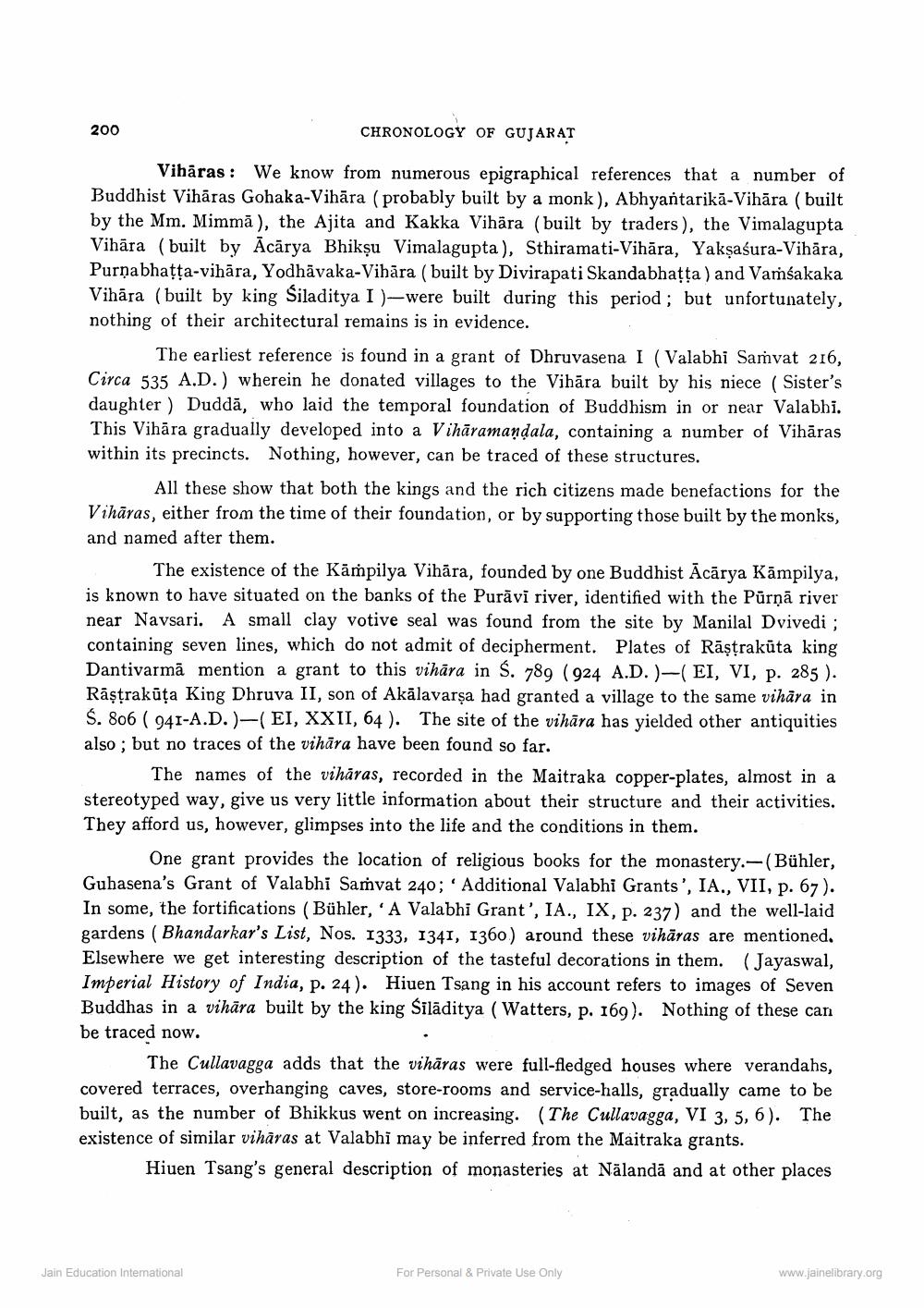________________
200
CHRONOLOGY OF GUJARAT
Vihäras: We know from numerous epigraphical references that a number of Buddhist Vihāras Gohaka-Vihāra (probably built by a monk), Abhyantarikā-Vihāra ( built by the Mm. Mimmā), the Ajita and Kakka Vihara (built by traders), the Vimalagupta Vihära (built by Ācārya Bhikṣu Vimalagupta), Sthiramati-Vihāra, Yakşaśura-Vihāra, Purnabhațţa-vihāra, Yodhāvaka-Vihāra (built by Divirapati Skandabhasta ) and Vamśakaka Vihāra (built by king Siladitya I )-were built during this period; but unfortunately, nothing of their architectural remains is in evidence.
The earliest reference is found in a grant of Dhruvasena I (Valabhi Samvat 216, Circa 535 A.D.) wherein he donated villages to the Vihāra built by his niece ( Sister's daughter ) Duddă, who laid the temporal foundation of Buddhism in or near Valabhi.
This Vihāra gradually developed into a Vihāramandala, containing a number of Vihāras within its precincts. Nothing, however, can be traced of these structures.
All these show that both the kings and the rich citizens made benefactions for the Vihāras, either from the time of their foundation, or by supporting those built by the monks, and named after them.
The existence of the Kāṁpilya Vihāra, founded by one Buddhist Ācārya Kämpilya, is known to have situated on the banks of the Purăvi river, identified with the Pūrņā river near Navsari. A small clay votive seal was found from the site by Manilal Dvivedi ; containing seven lines, which do not admit of decipherment. Plates of Rāşțrakūta king Dantivarmä mention a grant to this vihāra in $. 789 (924 A.D.)–(EI, VI, p. 285 ). Rāştrakūta King Dhruva II, son of Akälavarşa had granted a village to the same vihāra in Ś. 806 ( 941-A.D.)–(EI, XXII, 64). The site of the vihāra has yielded other antiquities also; but no traces of the vihāra have been found so far.
The names of the vihāras, recorded in the Maitraka copper-plates, almost in a stereotyped way, give us very little information about their structure and their activities. They afford us, however, glimpses into the life and the conditions in them.
One grant provides the location of religious books for the monastery.-(Bühler, Guhasena's Grant of Valabhi Samvat 240; 'Additional Valabhi Grants', IA., VII, p. 67). In some, the fortifications (Bühler, 'A Valabhi Grant', IA., IX, p. 237) and the well-laid gardens ( Bhandarkar's List, Nos. 1333, 1341, 1360) around these vihāras are mentioned. Elsewhere we get interesting description of the tasteful decorations in them. (Jayaswal, Imperial History of India, p. 24). Hiuen Tsang in his account refers to images of Seven Buddhas in a vihāra built by the king Silāditya (Watters, p. 169). Nothing of these can be traced now.
The Cullavagga adds that the vihāras were full-fledged houses where verandahs, covered terraces, overhanging caves, store-rooms and service-halls, gradually came to be built, as the number of Bhikkus went on increasing. (The Cullavagga, VI 3, 5, 6). The existence of similar vihāras at Valabhi may be inferred from the Maitraka grants.
Hiuen Tsang's general description of monasteries at Nälanda and at other places
Jain Education International
For Personal & Private Use Only
www.jainelibrary.org




